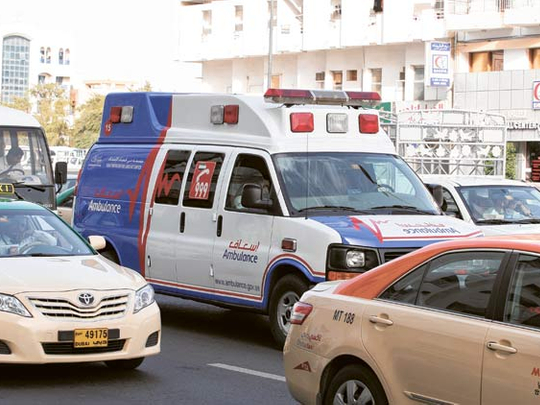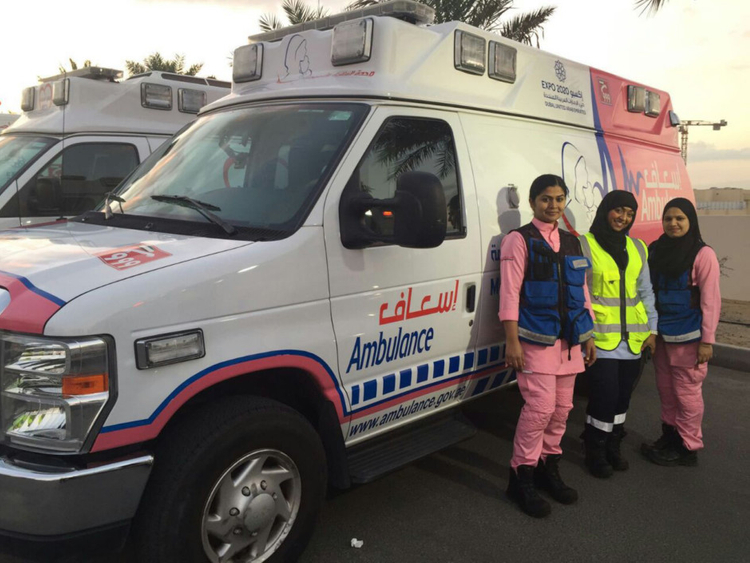
Dubai: Motorists who fail to give way to ambulances could be the reason behind the loss of someone’s life, emergency drivers and officials have said.
Amid concerns over the growing number of issues being faced by ambulance drivers, Dubai Police and Dubai Corporation for Ambulance Services (DCAS) are urging motorists to be more considerate and attentive to the sounds of sirens and warning lights of emergency cars.
Dubai Police launched ‘Give way for emergency vehicles, save a life’ campaign recently to raise awareness on how emergency vehicles cannot sometimes reach their respective destination on time because of drivers who do not give way.
In 2016, Dubai Police fined 128 motorists for failing to give way to police, ambulance and Civil Defence cars.
Talking to Gulf News, ambulance drivers described the risks they face regularly when motorists do not give way. This road behaviour, they said, poses a risk for both the ambulance driver and the patient being transferred, as the ambulance has to force its way between vehicles.
Mohammad Al Kheder, an ambulance driver with DCAS for the past year, says he sees this happen very often when responding to an emergency and believes some motorists either do not know how to react to the situation or simply choose not to give way because they don’t care.
“I have noticed people don’t realise there’s an emergency vehicle trying to pass through. We have to force our way to save the patient and overtake between the cars because cars won’t let us pass. This puts us and the patient at risk of getting into an accident and not being able to reach on time.”
Some, he says, do not know what to do and panic. This is especially common among new drivers.
“It’s not easy for us to find our way between cars and people need to know that it’s an emergency when the sirens and lights are on and should give us space. We’ve also noticed some motorists who get confused and instead block the road.”
He said even though some drivers may have had the intention of moving for the emergency vehicle, the way they move to make space can cause an accident. “I believe motorists should be trained by driving centres on how to give way to emergency vehicles.”
Khulood Noor Khan, working as an ambulance driver with DCAS for the last two years, described it as a ‘big problem’ that she experiences regularly. She also said it becomes a burden on her when people don’t give way as she tries to save a life.
“It gets extremely difficult and stressful for me to get to the patient or transfer the patient to the hospital within a few minutes, and many times I have faced this issue where people don’t give me way, but I do my best to reach on time.”
Khan, who mostly transfers moderate to severe cases, says motorists should know that a moderate case can turn severe at any second if they don’t move fast.
“It’s a big responsibility that we feel as ambulance drivers to save people, we could feel guilty if we were not able to do our job properly because of errant motorists. We ask everyone to please give way because they do not know the case in the car with us.”
Births inside ambulances
Out of 49 cases of births inside ambulances in 2015, several of them were as a result of delays on the road, confirmed Khalifa Bin Darri, executive director of DCAS.
“What some drivers on the road need to know is that when they don’t give way to an ambulance for example, the case being dealt with can turn moderate if it was mild or in other cases severe if it was first moderate. Every second counts here,” he said.
The current fine for failing to give way is Dh500 and four black points on the driver’s licence. However, there have been recent recommendations to increase it, said Bin Darri.
“We get around 500 emergency calls every day for all kinds of cases. No matter what the case is, cars should automatically move out of the way. It becomes very challenging for our ambulance drivers, especially during traffic or on narrow roads.”
Dubai Police have been constantly sendingt tweets on their official Twitter page to ensure full awareness among the community
“The ambulance could be heading to an accident or transferring someone to the hospital. There should always be space given to ambulance drivers. Our current response time is eight minutes but to reach our goal of four minutes by 2020, it could be a major challenge.”
Bin Darri pointed out that some motorists fail to give way because they are busy on the phone or not concentrating on the road. “Others simply do not care because it’s not their family inside the ambulance.”
To simply give way to ambulance cars, he said, “motorists can take a slight right or left to leave some space”.
Ambulance drivers, he added, have been instructed to report drivers disrupting their way “but many of our ambulance drivers say that the only thing they have on their mind that minute is to reach the accident site or transfer patients in the shortest time-frame”.
Bin Darri said he once received a call from an Emirati man who was very bothered when the cars were not giving way for the ambulance car transferring his mother to the hospital.
“He was really bothered because as he was driving behind the ambulance, he noticed that the ambulance car was slowing down and could not move forward. He then became aware that the car in front of the ambulance was the reason. The Emirati guy drove beside the other car and told him it could be their mother or sister in that car.”
Some errant motorists sometimes take advantage of rushing ambulance cars during rush hour and drive behind them to reach faster, he added.













